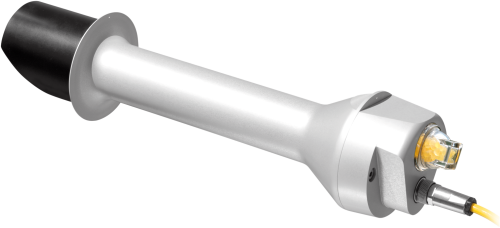






Overview
The CHP1-L, manufactured by Kipp & Zonen and cabled by Campbell Scientific, is a pyrheliometer used for unattended direct solar-radiation measurements. It is designed specifically to measure the direct beam solar irradiance with a field of view limited to 5 degrees. This is achieved by the shape of the collimation tube, precision apertures, and the detector design.
Read More
Benefits and Features
- ISO First Class
- Built-in temperature sensors
Images

Detailed Description
To monitor direct normal irradiance, a CHP1 Pyrheliometer is mounted to a user-supplied sun tracker such as Kipp & Zonen's Solys2. The CHP1 pyrheliometer measures the direct-beam solar irradiance with a field of view limited to 5 degrees. The limited field of view requires the CHP1 to be continuously pointed toward the sun. The Solys2 Sun Tracker rotates on two axes and uses a GPS receiver to keep the CHP1 aimed at the sun throughout the day.
Specifications
| Spectral Range | 200 to 4000 nm |
| Sensitivity | 7 to 14 µV/W/m2 |
| Response Time | < 5 s |
| Zero Offset B | < 1 W/m2 |
| Temperature Dependence of Sensitivity | < 0.5% (-20° to +50°C) |
| Field of View (FOV) | 5° ±0.2° |
| Operating Temperature Range | -40° to +80°C |
| Non-Linearity | < 0.2% |
| Maximum Irradiance | 4000 W/m2 |
| International Standards | First Class ISO |
| Body Diameter | 3.8 cm (1.5 in.) |
| Base Diameter | 7.6 cm (3.0 in.) |
| Length | 31.6 cm (12.4 in.) |
| Weight | 0.9 kg (1.98 lb) excluding cable |
Documents
Frequently Asked Questions
Number of FAQs related to CHP1-L: 12
Expand AllCollapse All
-
Ideally, the window should be cleaned every morning.
-
The CHP1-L is a pyrheliometer, manufactured by Kipp & Zonen, that measures the direct beam irradiance from the sun within a 5 degree solid angle around the sun.
-
Yes, but only under certain conditions. The most common condition for a negative output signal occurs during nighttime measurements when the temperature of space is less than the sensor’s temperature.
-
Every two years.
-
Absolutely. Because the CHP1-L measures the direct beam solar irradiance, it must follow the sun and remain within the limits of the 5 degree field of view to provide accurate measurements.
-
A pyrheliometer, such as the CHP1-L, has a window through which sunlight enters. The sunlight, or incident solar short-wave radiation, is directed onto an electronic device called a thermopile. Using the thermoelectric effect, the thermopile acts as a large thermocouple that measures the temperature of a particular body—in this case, the sun. The thermal energy is converted into a voltage output signal that can be recorded by Campbell Scientific data loggers.
-
Yes. The internal temperature can be measured using either the PT100 or thermistor built into the sensor.
-
The CHP1-L is typically mounted to a user-supplied sun tracker, such as Kipp & Zonen’s Solys2 or EKO Instruments’ STR-21G/22G.
-
Not every sensor has different cable termination options. The options available for a particular sensor can be checked by looking in two places in the Ordering information area of the sensor product page:
- Model number
- Cable Termination Options list
If a sensor is offered in an –ET, –ETM, –LC, –LQ, or –QD version, that option’s availability is reflected in the sensor model number. For example, the 034B is offered as the 034B-ET, 034B-ETM, 034B-LC, 034B-LQ, and 034B-QD.
All of the other cable termination options, if available, are listed on the Ordering information area of the sensor product page under “Cable Termination Options.” For example, the 034B-L Wind Set is offered with the –CWS, –PT, and –PW options, as shown in the Ordering information area of the 034B-L product page.
Note: As newer products are added to our inventory, typically, we will list multiple cable termination options under a single sensor model rather than creating multiple model numbers. For example, the HC2S3-L has a –C cable termination option for connecting it to a CS110 instead of offering an HC2S3-LC model.
Case Studies
The small southern Alberta city of Medicine Hat is the first city in the world......read more
Privacy Policy Update
We've updated our privacy policy. Learn More
